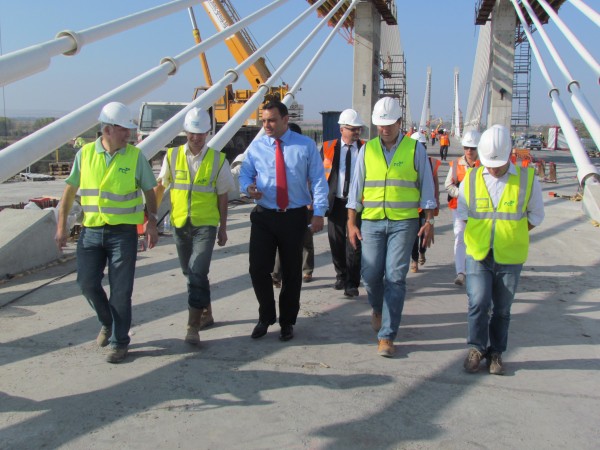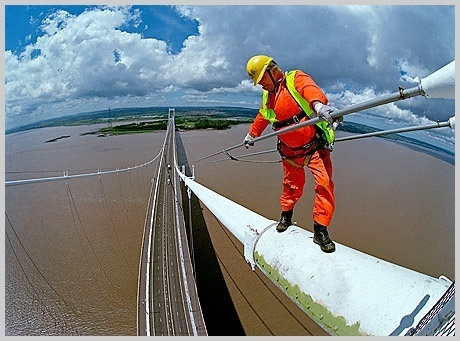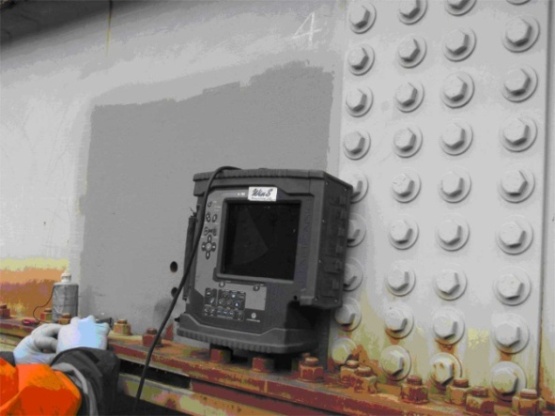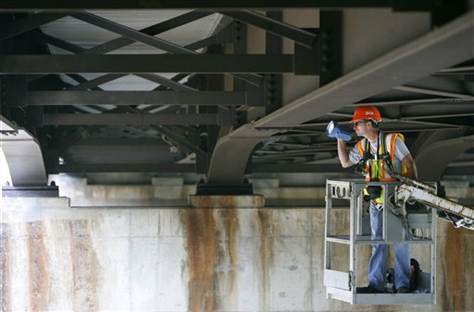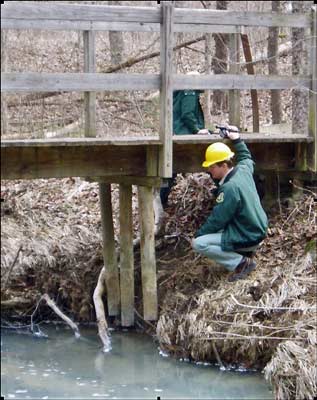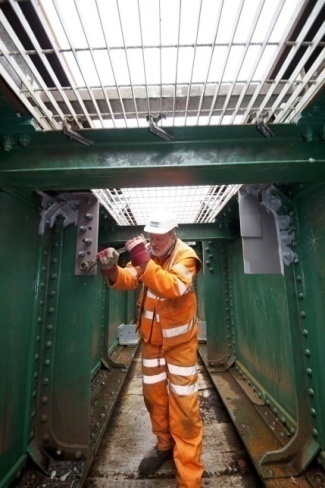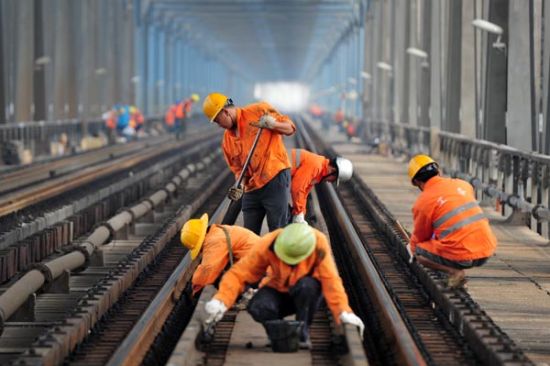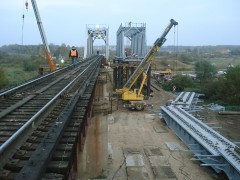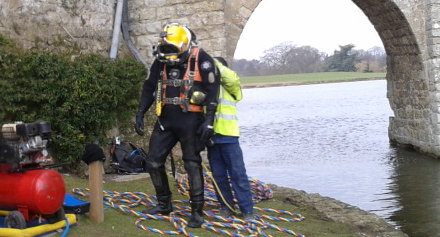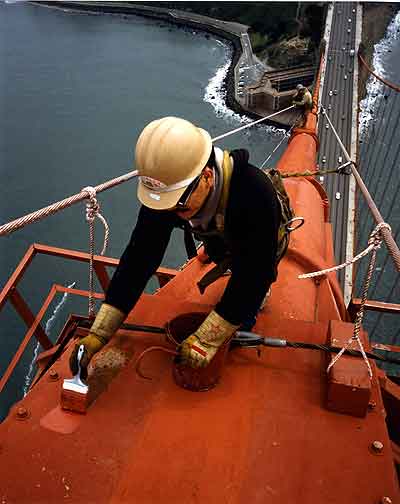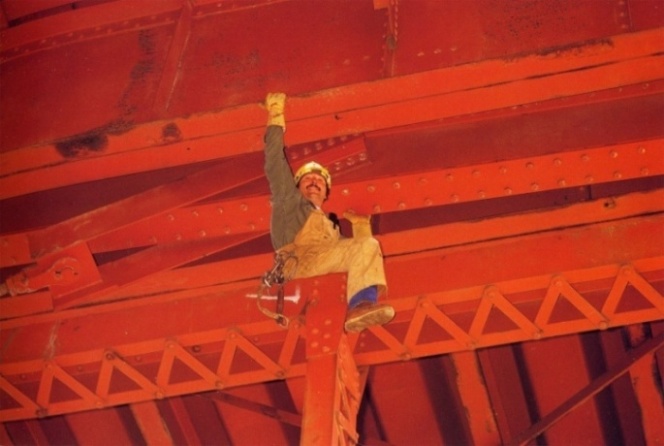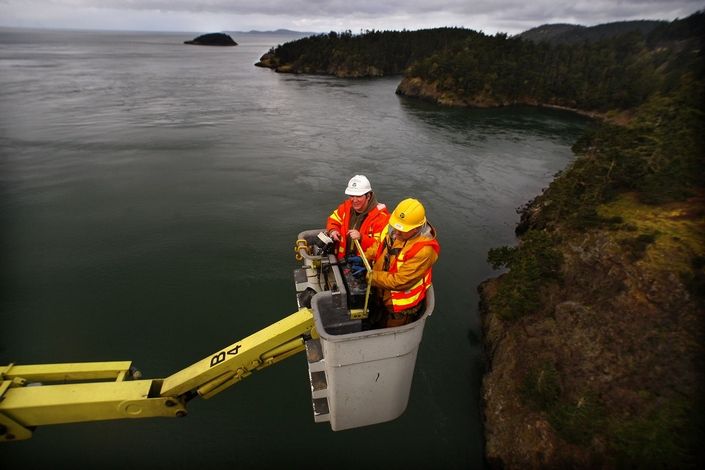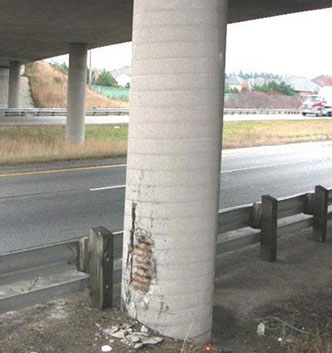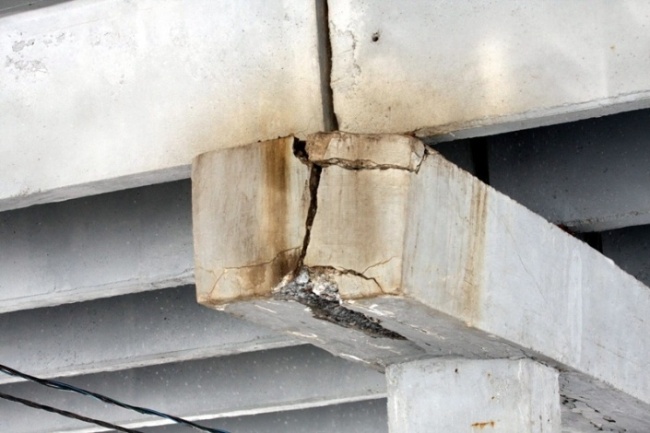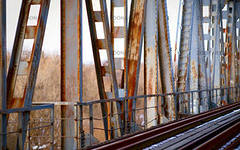
- •Росжелдор
- •Unit 1 railway and motorway engineering structures
- •First, scan the text and then read it more carefully
- •1.2 Give the equivalents in Russian of the following terms
- •1.3 What are the English equivalents of the following Russian terms?
- •1.4 Complete and translate the following sentences using the word list
- •1.5 Translate into English the following sentences
- •1.6 Match the English and Russian terms
- •1.7 Answer the following questions
- •1.8 Render the text according to your plan and give the names of most famous railway and motorway engineering structures in Russia and abroad Unit 2 bridge crossing and its components
- •2.1 Read the following text and make a plan for it
- •Superstructure (пролётное строение); 2 – Pier (опора); 3 – Abutment (устой);
- •2.2 Give the Russian equivalents of the following terms
- •2.3 Give the English equivalents of the following terms
- •2.4 Complete and translate the following sentences
- •2.5 Translate into English the following sentences
- •2.6 Match the words in column a with column b
- •2.7 Read the questions and see if you can answer them
- •2.8 Render the text according to your plan Unit 3 bridge classification
- •3.1 Read the text and make up a bridgework glossary in Russian
- •3.2 Find the Russian equivalents for the following English terms
- •3.3 Find the English equivalents to the following Russian terms
- •3.4 Complete and translate the following sentences
- •3.5 Translate into English the following sentences
- •3.6 Answer the questions
- •3.7 Describe different bridge structures according to their structural design using the terminology below
- •Unit 4 bridges of moscow
- •4.1 Read the text to have a basic notion of bridges in the capital of Russia.
- •4.2 Find the Russian equivalents for the following English terms
- •4.3 Find the English equivalents to the following Russian terms:
- •4.4 Match English and Russian bridge terminology:
- •4.5 Complete and translate the sentences using the following terms
- •4.6 Translate into English the following sentences
- •4.7 Answer the following questions
- •4.8 Render the text according to your plan Unit 5 bridges of st petersburg
- •5.1 Have you ever been to St Petersburg? If so, try to complement the text with your own information. If not, try to enhance your professional range of knowledge
- •5.10 Translate the text into English
- •Unit 6 timber and masonry bridges
- •6.1 Read the text about different building materials. Compare them and say which one is more suitable for permanent or temporary structures
- •6.6 Complete and translate the following sentences
- •6.7 Translate the following sentences into English
- •6.8 Give a reason to support what you say answering to these questions
- •6.9 Express your ideas about the building qualities of stone and wood Unit 7 reinforced concrete bridges
- •7.1 Read the text and learn the terminology using the list of words
- •7.2 Find the Russian equivalents for the following English terms
- •7.3 Find the English equivalents to the following Russian terms
- •7.4 Make up the questions to the following answers
- •7.5 Complete and translate the following sentences using the Word list
- •7.6 Translate the following sentences into English
- •7.7 Discuss the following questions
- •Unit 8 metal bridges
- •8.1 Think of different building materials and answer the following questions
- •8.2 Read the text and check your answers. How much did you guess correctly?
- •8.3 Find the Russian equivalents for the following English terms
- •8.4 What are the English equivalents for the following Russian terms?
- •8.5 Say whether these statements are true
- •8.6 Match the Russian and English terms
- •8.7 Complete and translate the following sentences
- •8.8 Translate the following sentences into English
- •Unit 9 bridges of great britain
- •9.1 Read the text and improve your knowledge of foreign experiences in bridge building
- •9.2 Tell the story of the Old London Bridge using the following terms
- •9.3 Read the text about famous London bridges and tell about them
- •9.4 Find the Russian equivalents for the following English terms
- •9.5 Read the text about the most astonishing British bridges and tell about them
- •9.6 Find the Russian equivalents for the following English terms
- •9.7 Complete and translate the following text
- •9.8 Complete the following sentences using your own ideas
- •9.9 Answer the following questions
- •9.10 Translate the text into English
- •10.1 After reading the text, prove the idea that suspension structures are the safest among bridgeworks
- •10.2 Find the Russian equivalents for the following English terms
- •10.3 Make up examples with the terms describing a suspension structure
- •10.4 Choose which statements are true
- •10.5 Complete and translate the following sentences
- •10.6 Translate the following sentences into English
- •10.7 Answer the following questions
- •10.8 Describe the Golden Gate Bridge using the following information
- •10.9 Consult this list of bridge terminology while doing the exercises
- •Unit 11 bridges of novosibirsk
- •11.1 Having read the text, complete the information with details you may notice in the pictures
- •11.2 Find the Russian equivalents for the following English terms
- •11.3 Find the Russian equivalents for the following English terms
- •11.4 Match the English and Russian terms
- •11.5 Translate the following sentences into English
- •11.6 Answer the following questions
- •11.7 What bridge across the Ob River do you prefer and why? Express your opinion using the following word combinations
- •11.8 Describe your “dream bridge”. Do you have any ideas that will surprise your classmates? Think of a place for “your” bridge. Unit 12 bridge or tunnel?
- •12.1 Read the text and give your reasons for making a choice between a bridge and a tunnel
- •12.2 Find the Russian equivalents for the following English terms
- •12.3 Find the Russian equivalents for the following English terms
- •12.4 Complete and translate the following sentences using the word list
- •12.5 Translate the following sentences into English
- •12.6 Think over the problems and give your reasons for the right solution
- •12.7 Read this interview and make up your own dialogue using the following expressions
- •Unit 13 construction of supports and foundations
- •13.1 Read the text to get a clear idea of building materials and construction technologies for piers and foundations. Go down the word list and take note of professional terminology.
- •13.2 Find the Russian equivalents for the following English terms
- •13.3 Find the Russian equivalents for the following English terms
- •13.4 Translate the following information into Russian, consulting the terminology list and using the word combinations given below
- •13.5 Translate the following information into English using the terminology list
- •13.6 Give your reasons to support the answers to these questions
- •Unit 14 superstructure construction
- •14.1 Read the text and pay attention to the differences in the various techniques of superstructure construction
- •14.2 Find the Russian equivalents for the following English terms
- •14.3 Find the Russian equivalents for the following English terms
- •14.4 Complete and translate the following sentences using the terminology from previous text and the word list (14.6)
- •14.5 Translate the following sentences into English
- •14.6 Find the relevant information in the texts to answer these questions
- •14.7 Describe superstructure construction methods using the following word combinations
- •Unit 15 construction of suspension and cable-stayed bridges
- •15.1 Read the text and pay attention to the peculiarities of suspension superstructure construction
- •15.2 Find the Russian equivalents for the following English terms
- •15.3 Find the Russian equivalents for the following English terms
- •15.4 Complete and translate the sentences using the following words
- •15.5 Translate the following sentences into English
- •15.6 Find the relevant information in the texts to answer these questions
- •15.7 Describe superstructure construction methods. Remember the following word combinations
- •Unit 16 bridge maintenance
- •16.1 Read the text and make a list of the main ideas you should remember as a future bridge builder
- •16.2 Find the Russian equivalents for the following English terms:
- •16.3 Find the English equivalents for the following Russian terms
- •16.4 Match the equivalents
- •16.5 Complete the following sentences
- •16.6 Read the text and find the equivalents for the following terms
- •16.7 Translate the following sentences into English using terminology from this unit
- •16.8 Find the answers to these questions in the text
- •16.9 Role-play. “On-site review and visual inspection of the bridge components”
- •Unit 17 tunnel classification
- •17.1 Read the text and make a list of tunneling terminology
- •17.2 Find the Russian equivalents for the following English terms
- •17.3 Find the English equivalents for the following Russian terms
- •17.4 Complete and translate the following sentences using the Word list.
- •8 Side Wall Drift (боковая штросса); 9 – Lining (обделка тоннеля);
- •– Tunnel Foot (подошва тоннеля)
- •17.5 Translate the following sentences into English using terminology from the texts. Tell a partner what you found most interesting
- •17.5 Answer the questions using the information from the text and your own ideas
- •17.6 Describe any tunnel using the information model from the following.
- •Unit 18 construction methods of tunnels
- •18.1 Read the text and define recent trends in unneling
- •18.2 Find the Russian equivalents for the following English terms
- •18.3 Find the English equivalents for the following Russian terms
- •18.4 Complete the following sentences using the word list and translate them
- •18.5 Translate the following sentences into English using terminology from previous texts
- •18.6 Make up the answers to these questions. Use the Word list
- •18.7 Read the dialogue below and retell it with a partner
- •18.8 Disagree with each statement
- •Unit 19 shield tunnelling
- •19.1 Read the text to have an idea of state-of-the-art tbm’s
- •Figure 19. 7 Technological Process by the Slurry Shield Complex
- •19.2 Find the Russian equivalents for the following English terms
- •19.3 Find the English equivalents for each of the Russian terms
- •19.4 Complete and translate the following sentences using the list of word combinations below
- •19.5 Complete the following sentences using your own ideas and the Word list below.
- •19.6 Translate the sentences into English
- •19.7 Answer the following questions
- •Unit 20 general idea of the metro
- •20.1 Read the text and find out peculiarities in the underground railway systems of different countries
- •20.2 Find the Russian equivalents for the following English terms
- •20.3 Find the English equivalents for each of the Russian terms from the text
- •20.4 Complete and translate the sentences using the following words and word combinations
- •20.6 Think of the answers and give a reason to support what you say
- •20.7 Complete the following sentences in a suitable way
- •20.8 Discuss the ideas expressed by these two engineers suggesting their solution of public transport development in modern cities
- •Unit 21 the novosibirsk metro
- •21.1 Read the text and complement it with more details from the history and present-day operation of the Novosibirsk Metro
- •21.2 Find the Russian equivalents for the following English terms
- •21.3 Find the English equivalents for each of the Russian terms
- •21.4 Complete the sentences using the following words and render this text in English
- •21.5 Complete and translate the following sentences
- •21.6 Discuss the following questions
- •21.7 Read the dialogue and compose your own conversation with a partner. Use the words and expressions from the model
- •21.8 Try to guess the meaning of the following word combination
- •21.10 Ask each other questions to test your knowledge of the unit Unit 22 structures in the underground
- •22.1 Read the text consulting the Word list for better understanding
- •22.2 Find the Russian equivalents for the following English terms
- •22.3 Find the English equivalents for each of the Russian terms from the text
- •22.4 Translate the sentences using the necessary English equivalents.
- •22.5 Translate the sentences into English paing attention to relevant terminology
- •22.6 Choose which statement is true
- •22.7 Discuss the following questions
- •Unit 23 tunnel maintenance
- •23.1 Having read the text try to prove the idea that tunnel maintenance is much more expensive compared to bridge maintenance. Give your reasons
- •23.2 Find the Russian equivalents for the following English terms
- •23.3 Find the English equivalents for each of the Russian terms
- •23.4 Complete the sentences using the following words
- •23.5 Complete and translate the following sentences
- •23.6 Answer the questions
- •Unit 24 сollapse of bridges and tunnels
- •24.1 Read the text, try to guess the meaning of the words you do not know, and then analyze how many meanings you can guess correctly or nearly correctly
- •24.2 Find the Russian equivalents for the following English terms
- •24.3 Find the English equivalents for each of the Russian terms
- •24.4 Complete the sentences using the following words and translate them into Russian
- •24.5 Translate the sentences into English paying attention to relevant terminology
- •24.6 Working in pairs, practice the questions below and support your opinion by using vivid examples. Make up your own questions
- •Unit 25
- •25.1 Read the text and try to complement its content with detailed information and interesting facts
- •25.2 Find the Russian equivalents for the following English terms and word combinations
- •25.3 Find the English equivalents for each of the Russian terms from the text
- •25.4 Complete the sentences using the following words and translate them into Russian
- •25.5 Complete and translate the following sentences
- •25.6 Answer the following questions
Unit 16 bridge maintenance
16.1 Read the text and make a list of the main ideas you should remember as a future bridge builder
Bridge engineers plan their structures so that experts can easily inspect and maintain them. Once the bridge has been built, the State Acceptance Committee determines its availability status. Experts in the commission study all the documents, provide an on-site review and make visual inspection of the bridge components (fig.16.1). They examine them with geodetic devices to locate defects before they turn into a serious problem.
|
|
a – Experts are making visual inspection |
b- Bridge Inspector is assessing cable-stay condition |
Figure 16.1 Experts are inspecting a bridge
During acceptance inspection every structural element of the bridge is tested under static (fig. 16.2a) and dynamic loads (fig. 16.2b). Skilful specialists carefully examine welding and joints, which can change their initial position under an emergency load. If the structure meets the standard requirements and the acceptance documents are signed, the ownership of the bridge is transferred to the Railway and Motorway authorities or agents.
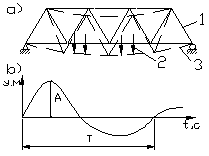
Figure 16.2 Diagram of Bridge Testing Under Static and Dynamic Loads
(схема проверки моста под постоянными и динамическими нагрузками):
a – Testing under Static Loads (проверка под статическими нагрузками);
b – Testing under Dynamic Loads (проверка под динамическими нагрузками);
1 – Superstructure (пролётное строение); 2 – Loads (нагрузки);
3 –Bridge after Deformation (мост после деформации);
4 – Vibration Amplitude (амплитуда колебаний); 5 – Period of Vibration (период колебаний)
Bridge maintenance presents many challenges even if a bridge is new. Steel bridges require a lot of maintenance in coastal regions because moisture and salts cause corrosion in the bridge components.
|
|
a – Bridge Inspector is using Ultrasonic testing during the inspection of a bridge. |
b - A regularly scheduled inspection of bridge components |
|
|
c – Emergency state of a timber bridge |
d - Routine inspection of bridge components and high-strength bolts |
Figure 16.3 Bridge Inspection
Coastal areas are also difficult environments for reinforced concrete bridges because moisture penetrates the concrete structure, deteriorates it and causes corrosion (fig.16.3a, b). Water can cause soil erosion making a bridge scour, undermine the footing and expose the piles. Substructure may be deteriorated at the water line, and suffer from cracking or impact damage caused by boats under the bridge, etc. Timber bridges can decay and be attacked by vermin (fig.16.3c). Bridges often need inspection after a flood event, onslaught of wind, fire, collision with boats or traffic accidents.
The Trans-Siberian Railway runs through permafrost areas, and bridges along this main trunk line require costly upkeep. As a lot of ice melts each summer, continual maintenance includes track leveling on railroad bridges (fig.16.4). In winter, extensive maintenance is also required to combat lifting up by frost when local displacements of 2.5 to 35 cm occur in roadbeds and bridges.
|
|
a - Workers examine the track on a railway bridge |
b – After-inspection track repair on railway bridges |
Figure 16.4 Scheduled inspection and repair on railway bridges
Detailed visual bridge inspection includes not only checking the general condition of the structure but also looking for any problems with concrete or steel materials. The inspector must assess each bridge component and identify additional testing or repairs if needed. The information is reported to supervising engineers and maintenance crews. In case of emergency, a trained, professional engineer and a repair crew immediately fix the problem. An emergency inspection is usually carried out after a flood event, an earthquake or a vehicle collision that damage bridge components.
Experts are responsible for safe bridge function, so they inspect and correct structures by running maintenance, preventive maintenance, scheduled bridge repairs, emergency repairs and overhaul. Preventive bridge maintenance is cost-effective because it provides the structure serviceability and allows avoiding expensive repairs. Construction inspectors and maintenance workers provide continuous bridge inspection throughout its service life. The rules and demands for scheduled and emergency maintenance must be observed according to the guidelines established by either “Building Specifications” or “National Bridge Inspection Standards”. Currently, there are accurate techniques for testing bridge structural integrity and safety. These techniques insure that bridges meet up to their designed specifications.
Usual bridge maintenance includes monitoring of cracks in deteriorated concrete, continual keeping the deck clean, periodical removing debris from bridge deck expansion joints, repairing apparent damage on the roadway surface, careful inspection of anchoring devices, protective painting, etc. Common maintenance concerns are welds, corroded rivets and bearings. They must be regularly flushed with high-pressure water jets to remove harmful precipitations and collection of sand or debris. The workers cleanse bridge deck, sidewalks, parapets and light stands using compressed air and mechanical devices.
A civil engineer who assesses bridge condition is a Bridge Inspector or Structural Maintenance Engineer. He can perform tests to assess the aging of bridge components because he knows the behavior of bridge elements under different stress intensities. He assesses the structural damage caused by environmental influences or human actions. The experienced bridge inspector can work high up in the air (fig. 16.1b) or even underwater. Sometimes he has to put on underwater gear (16. 5a) to monitor the bridge components below the water surface or a scour around support columns.
|
|
a – Underwater Inspection of Bridge Components Condition |
b – Painting of corroding steel bridge components |
|
|
c – Examining and replacing of corroding steel bridge components |
|
Figure 16.5 Bridge Inspectors assess the aging bridge components
To perform all necessary engineering supervision of long bridges, deal with bridge load capacity and column strength, do damage inspection and look for corrosion and fatigue cracking, bridge inspectors employ various assessment techniques such as Infrared Thermography, Ultrasonic or Standard Visual Inspection, etc. and use sophisticated monitoring devices and in-place sensors. To provide reliable, trouble-free operation many bridges are outfitted with monitoring devices based on acoustic emission and nondestructive evaluation (NDE) technologies. These techniques detect the acoustic reflections from growing cracks that can lead to disastrous failure of concrete (fig.16.3a).
A Bridge Maintenance Supervisor heads a crew of maintenance workers and equipment operators to inspecs short bridges and culverts. They monitor bridge safety; help the Bridge Inspector, remove and patch deteriorated concrete pavements before catastrophic failures can happen. They are responsible for removing ice, snow, slush, and storm debris. This work may result in short-term lane closures when traffic is not heavy, usually by night, but sometimes during daylight hours.
|
|
a – Bridge maintenance personnel working in “skyboxes” |
b - Bridge pier column with chipped concrete marked as the first category condition |
|
|
с - Advanced deterioration with fatigue cracks marked as the second category condition |
d - The third category of bridge condition calling for reconstruction |
Figure 16.6 General maintenance inspection is provided around the clock for assessing the categories of bridge condition
Maintenance personnel provides around the clock service locating and fixing small damage and defects: electricians inspect the navigation lights on the towers and main cables; examine light stands; bridge painters work in "skyboxes" touching up the protective coatings. For instance, 38 painters maintaining its well-known rust-red color and 17 ironworkers examining 1.2 million rivets that are corroding under never-ending fog perform daily maintenance procedures on the Golden Gate Bridge, which is crossed by more than 100,000 vehicles each day. Painting, monitoring rust expansion and replacing corroding steel components is the primary maintenance job (fig.16.5; 16.6). Having found wear and the exact anomalous zones in bridge components, a maintenance crew fills in the forms and keeps detailed and accurate records of bridge inspections and testing. They also keep a written record of wear-out failures, which need general overhaul.
The assessment categories of bridge condition are ranging from zero to the third category. The condition marked as zero category is the standard bridge condition when no problems are noted. The first category means that nearly all bridge elements are safe but the structure may have minor damage and failures such as cracking, spalling or scour. The workers repaire this damage during running maintenance (fig. 16.6b).
The second category means that the primary structural components are suffered from advanced deterioration with fatigue cracks in steel segments and shear cracks in concrete that may result in a pothole.The bridge or the component under suspect must be closely monitored, and correction action may require immediate repair or complete overhaul (fig. 16.6c). The third category means imminent failure that calls for reconstruction or complete replacement, and the bridge is considered to be out service (fig. 16.6d).
Maintenance cost may influence the bridge type selection. Concrete bridges usually require the least maintenance, which is crack sealing for preventing and reducing rebar corrosion. Timber structures are also an easy bridge type to repair. For instance, the workers replace decayed or broken planks with no difficulty and quickly fasten sound planks by metal fasteners. Access for inspection and maintenance is among the priorities of bridge engineering.
Exercises

